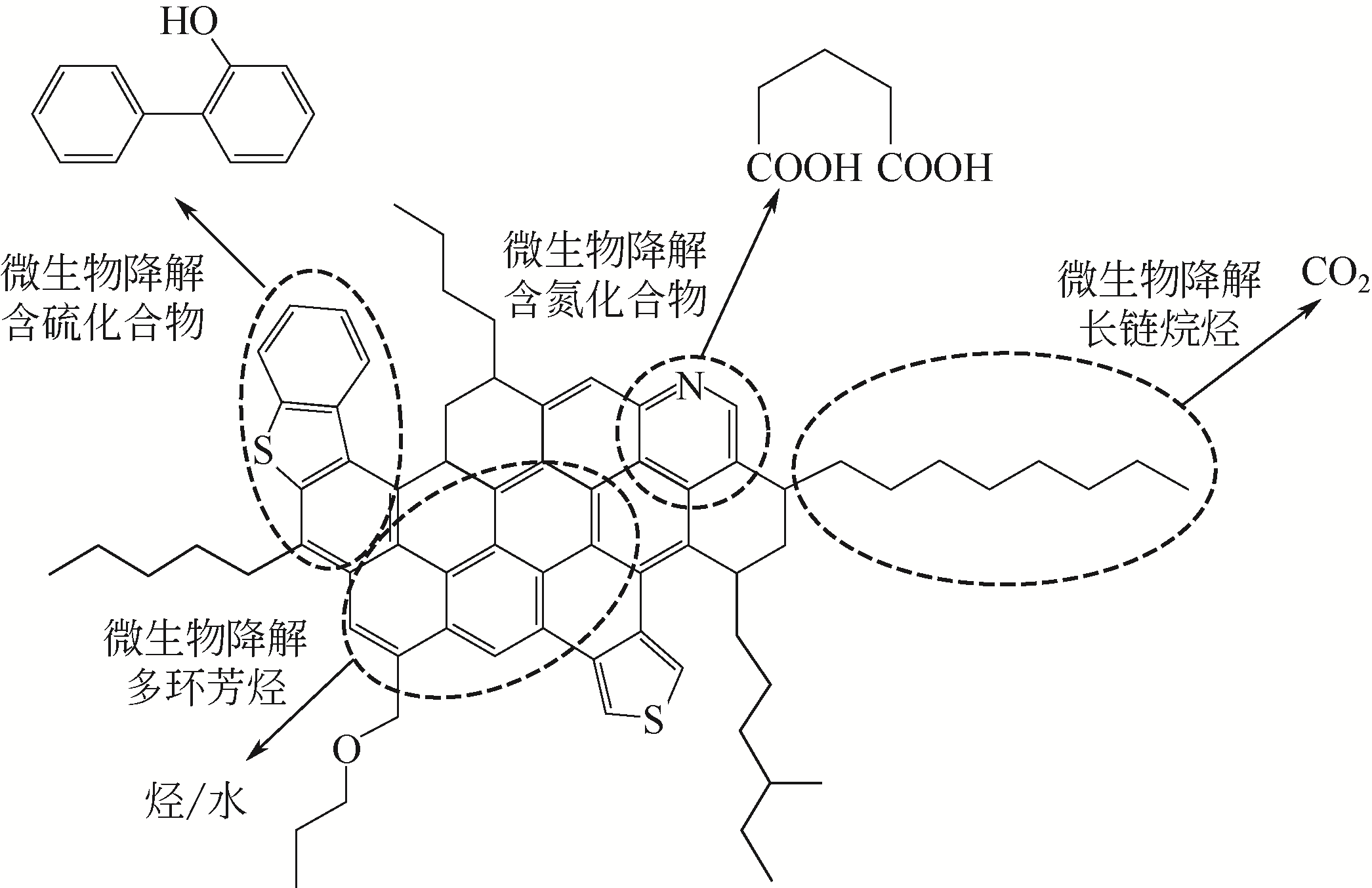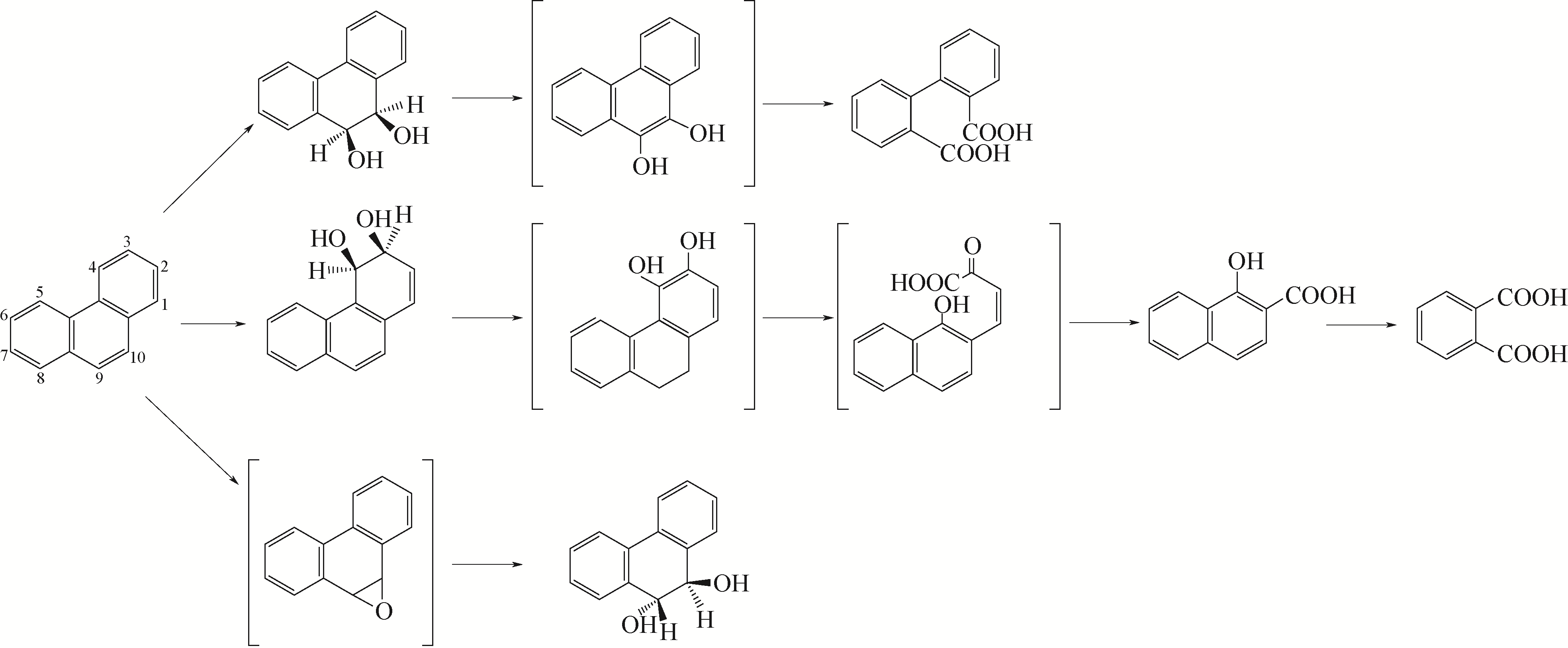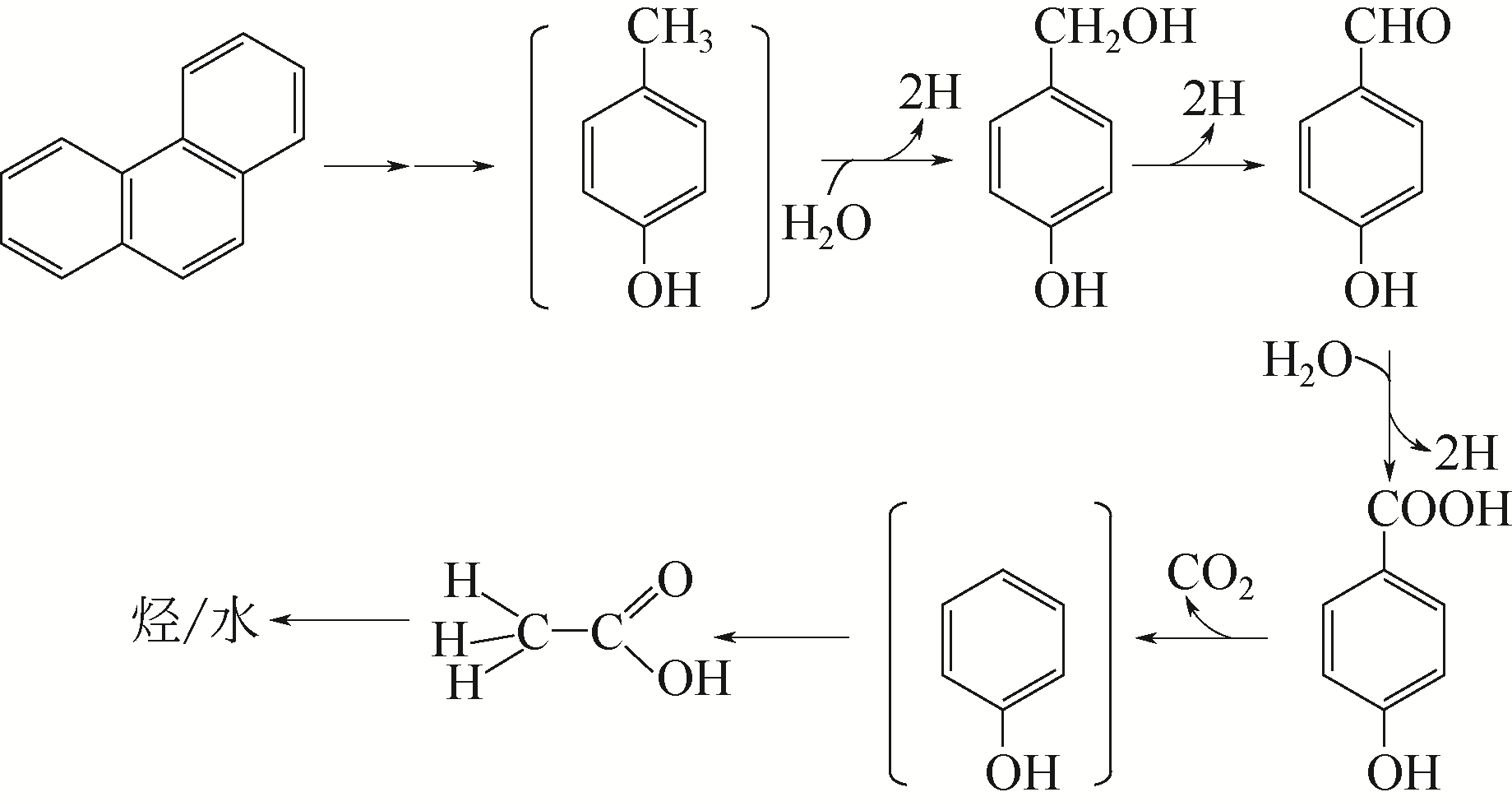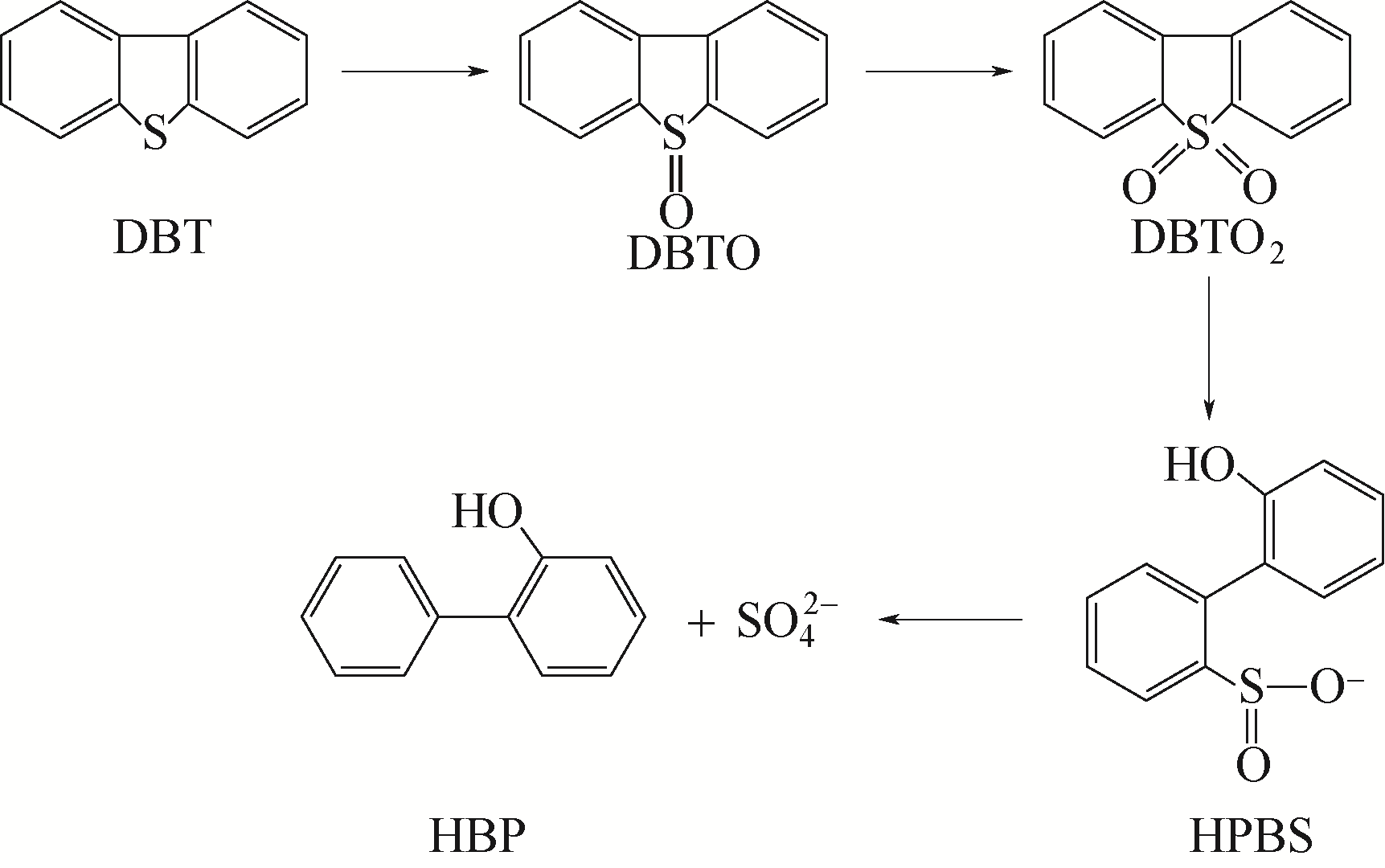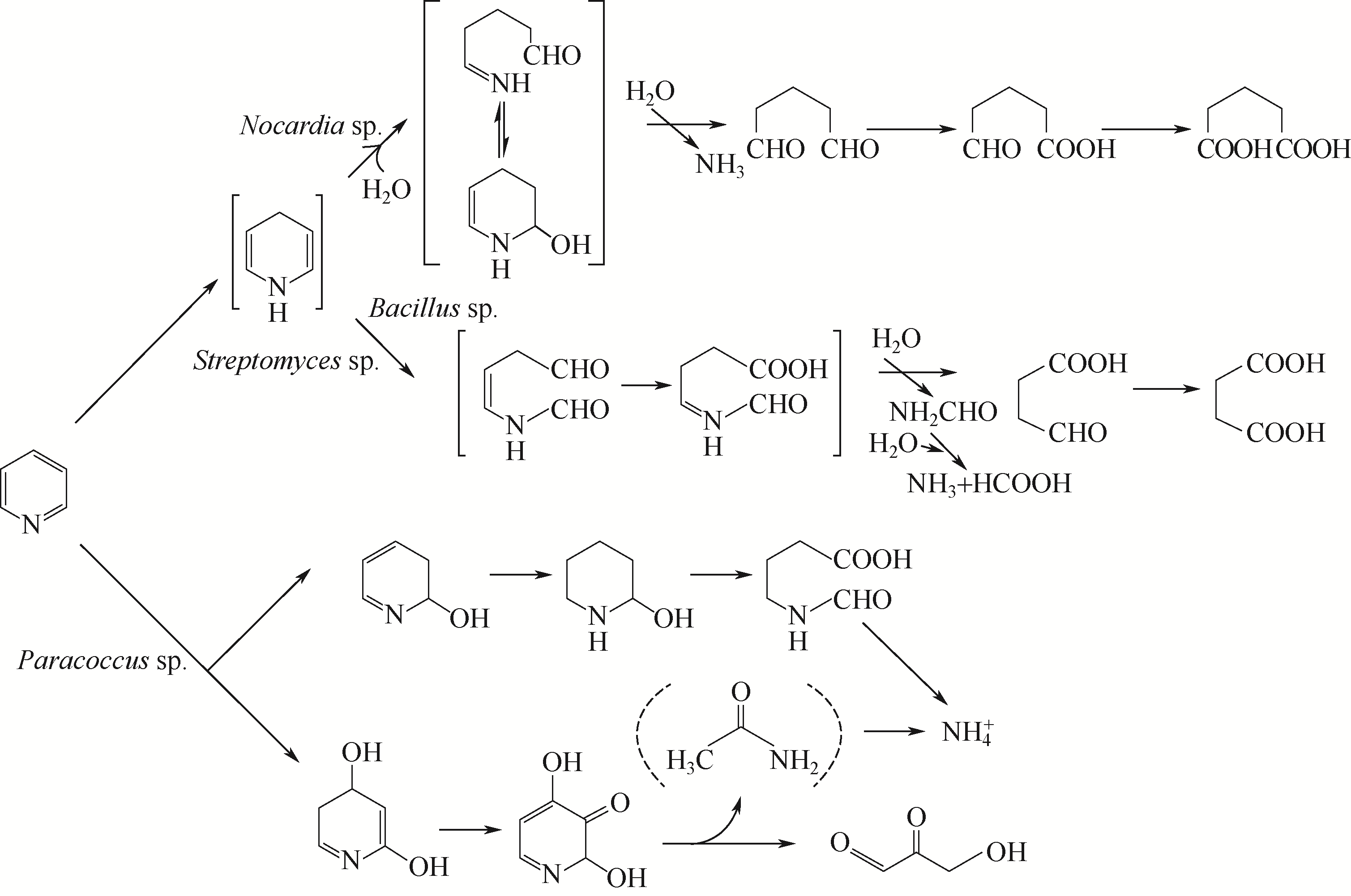化工进展 ›› 2021, Vol. 40 ›› Issue (3): 1574-1585.DOI: 10.16085/j.issn.1000-6613.2020-0746
微生物降解稠油中沥青质的研究进展
- 1.中国石油大学(北京)非常规油气科学技术研究院,温室气体封存与石油开采利用北京市重点实验室,北京 102249
2.中国石油大学(北京)新能源与材料学院,北京 102249
-
收稿日期:2020-05-06出版日期:2021-03-05发布日期:2021-03-17 -
通讯作者:刘琦 -
作者简介:于洋(1996—),女,硕士研究生,研究方向为油田化学工程。E-mail:2019216310@student.cup.edu.cn 。 -
基金资助:国家自然科学基金(51604288)
A review of the biodegradation of asphaltene in heavy oil
YU Yang1( ), LIU Qi1(
), LIU Qi1( ), PENG Bo1, LYU Jing2
), PENG Bo1, LYU Jing2
- 1.The Unconventional Petroleum Research Institute, Beijing Key Laboratory for Greenhouse Gas Storage and CO2-EOR, China University of Petroleum-Beijing, Beijing 102249, China
2.College of New Energy and Materials, China University of Petroleum, Beijing 102249, China
-
Received:2020-05-06Online:2021-03-05Published:2021-03-17 -
Contact:LIU Qi
摘要:
稠油因黏度高、流动性差,存在开采难度大、开发成本高的问题。沥青质等重组分含量高是造成稠油高黏度的主要原因。微生物通过降解重组分可降低稠油的平均分子量,从而降低稠油黏度。本文从沥青质的结构与组成出发,阐述了微生物对沥青质的降解机理,总结了近年来国内外最新研究进展,指出了目前微生物降解沥青质研究与应用所面临的挑战,并对其发展趋势做出了展望。微生物对沥青质的降解主要是通过将多环芳烃进行开环降解、将长链正构烷烃降解为短链、将杂环化合物进行开环除去杂原子三个方面。但因沥青质的分子量较大且组成有着不确定性,所筛选的微生物是否能够高效地降解储层中原油所含沥青质仍需进一步探究,因此高效沥青质降解菌株的筛选和利用基因工程等技术手段改造菌株应是未来工作的研究重点。此外,通过菌株的复配,利用菌株间的协同效应也可以达到更为高效降解沥青质的目的。
中图分类号:
引用本文
于洋, 刘琦, 彭勃, 吕静. 微生物降解稠油中沥青质的研究进展[J]. 化工进展, 2021, 40(3): 1574-1585.
YU Yang, LIU Qi, PENG Bo, LYU Jing. A review of the biodegradation of asphaltene in heavy oil[J]. Chemical Industry and Engineering Progress, 2021, 40(3): 1574-1585.
| 微生物类别 | 菌株名称 | 来源 | 参考文献 |
|---|---|---|---|
| 细菌 | 铜绿假单胞菌(Pseudomonas aeruginosa) | 含油土壤 | [ |
| 嗜盐菌(halophilic bacterium) | 原油 | [ | |
| 地衣芽孢杆菌(Bacillus licheniformis) | 原油和原油污染土壤 | [ | |
| 迟缓芽孢杆菌(Bacillus lentus) | 原油和原油污染土壤 | [ | |
| 蜡样芽孢杆菌(Bacillus cereus) | 原油和原油污染土壤 | [ | |
| 坚强芽孢杆菌(Bacillus firmus) | 原油和原油污染土壤 | [ | |
| Garciaella petrolearia | 海底石油管道 | [ | |
| 人型葡萄球菌(Staphylococcus hominis) | 石油污染土壤和污泥 | [ | |
| 荧光假单胞菌(Pseudomonas fluorescens) | 石油污染土壤和污泥 | [ | |
| 嗜酸柠檬杆菌(Citrobacter amalonaticus) | 石油污染土壤和污泥 | [ | |
| 阴沟肠杆菌(Enterobacter cloacae) | 石油污染土壤和污泥 | [ | |
| 梭状芽孢杆菌(Lysinibacillus fusiformis) | 石油污染土壤和污泥 | [ | |
| 真菌 | 费希新萨托菌(Neosartorya fischeri) | 天然沥青湖 | [ |
| 木腐菌(Daedaleopsis sp.) | 森林 | [ | |
| 苍白杆菌(Ochrobactrum) | 油田地层水 | [ |
表1 可降解沥青质的微生物
| 微生物类别 | 菌株名称 | 来源 | 参考文献 |
|---|---|---|---|
| 细菌 | 铜绿假单胞菌(Pseudomonas aeruginosa) | 含油土壤 | [ |
| 嗜盐菌(halophilic bacterium) | 原油 | [ | |
| 地衣芽孢杆菌(Bacillus licheniformis) | 原油和原油污染土壤 | [ | |
| 迟缓芽孢杆菌(Bacillus lentus) | 原油和原油污染土壤 | [ | |
| 蜡样芽孢杆菌(Bacillus cereus) | 原油和原油污染土壤 | [ | |
| 坚强芽孢杆菌(Bacillus firmus) | 原油和原油污染土壤 | [ | |
| Garciaella petrolearia | 海底石油管道 | [ | |
| 人型葡萄球菌(Staphylococcus hominis) | 石油污染土壤和污泥 | [ | |
| 荧光假单胞菌(Pseudomonas fluorescens) | 石油污染土壤和污泥 | [ | |
| 嗜酸柠檬杆菌(Citrobacter amalonaticus) | 石油污染土壤和污泥 | [ | |
| 阴沟肠杆菌(Enterobacter cloacae) | 石油污染土壤和污泥 | [ | |
| 梭状芽孢杆菌(Lysinibacillus fusiformis) | 石油污染土壤和污泥 | [ | |
| 真菌 | 费希新萨托菌(Neosartorya fischeri) | 天然沥青湖 | [ |
| 木腐菌(Daedaleopsis sp.) | 森林 | [ | |
| 苍白杆菌(Ochrobactrum) | 油田地层水 | [ |
| 复配形式 | 混合菌群 | 降解效果 | 参考文献 |
|---|---|---|---|
| 细菌之间 | 蜡样芽胞杆菌、氧微杆菌、阴沟肠杆菌、嗜麦芽寡养单胞菌 | 菌群在室温(25℃)原油黏度最大降幅为95.73%;一些复杂的多环芳烃降解为简单组分,简单芳烃组分含量显著增加 | [ |
| 金橙黄微小杆菌、鞘氨醇单胞菌属、芽孢杆菌、苍白杆菌属、多噬伯克霍尔德氏菌、红球菌属 | 以软沥青为底物,与单菌株相比,混合菌株降解率更高,30天内降解率可达42%±8% | [ | |
| 腐生葡萄球菌、蜡样芽胞杆菌 | 经过培育期后,混合菌群在45℃、盐度为160g/L、pH为6.50、初始沥青质浓度为25g/L条件下,沥青质降解率为46.71%,细菌群可将沥青质分子分解成更小的片段 | [ | |
| 根瘤菌属、克雷白氏杆菌属、芽孢杆菌属 | 混合菌群与单菌株相比,原油的各组分降解率都有很大提高,C13、2,3-二甲基萘、1,6,7-三甲基萘及C19的降解率都达到100% | [ | |
| 铜绿假单胞菌、荧光假单胞菌 | 在振动条件下,初始沥青质浓度为35g/L时,混合菌群两个月内能够在40℃下降解51.5%的沥青质 | [ | |
| 油杆菌、地芽孢杆菌 | 将两菌株等比例复配后作用稠油,稠油降解速率加快,原油族组分含量进一步降低,乳化稳定性增强,平均乳化粒径减小56.7%,作用后的稠油乳化黏度为20.59mPa·s,仅为初始黏度的3.9% | [ | |
| 真菌之间 | 曲霉属、镰刀菌属 | 利用混合真菌处理原油污染土壤,28天内,总石油烃降解率为92%,降解效果优于单个真菌 | [ |
| 青顶拟多孔菌、偏肿拟栓菌和糙皮侧耳菌 | 两两一组进行复配,偏肿拟栓菌与糙皮侧耳菌接种比例为1∶1时方案最优,复配后产生的酶活量均比单种菌产的酶活量高,复配后酶活的分泌量与菌株生长情况有关 | [ | |
| 细菌与真菌 | 细菌:枯草芽孢杆菌、高温烷烃地芽孢杆菌、芽孢杆菌、Glutamicibacter sp. 真菌:8种曲霉、3种酵母菌 | 利用连续细菌真菌混合培养对稠油的降解率为65.96%。微生物混合培养基对稠油的降解能力与最佳分离菌株相比使原油降解效率提高了约8% | [ |
表2 菌株协同降解沥青质
| 复配形式 | 混合菌群 | 降解效果 | 参考文献 |
|---|---|---|---|
| 细菌之间 | 蜡样芽胞杆菌、氧微杆菌、阴沟肠杆菌、嗜麦芽寡养单胞菌 | 菌群在室温(25℃)原油黏度最大降幅为95.73%;一些复杂的多环芳烃降解为简单组分,简单芳烃组分含量显著增加 | [ |
| 金橙黄微小杆菌、鞘氨醇单胞菌属、芽孢杆菌、苍白杆菌属、多噬伯克霍尔德氏菌、红球菌属 | 以软沥青为底物,与单菌株相比,混合菌株降解率更高,30天内降解率可达42%±8% | [ | |
| 腐生葡萄球菌、蜡样芽胞杆菌 | 经过培育期后,混合菌群在45℃、盐度为160g/L、pH为6.50、初始沥青质浓度为25g/L条件下,沥青质降解率为46.71%,细菌群可将沥青质分子分解成更小的片段 | [ | |
| 根瘤菌属、克雷白氏杆菌属、芽孢杆菌属 | 混合菌群与单菌株相比,原油的各组分降解率都有很大提高,C13、2,3-二甲基萘、1,6,7-三甲基萘及C19的降解率都达到100% | [ | |
| 铜绿假单胞菌、荧光假单胞菌 | 在振动条件下,初始沥青质浓度为35g/L时,混合菌群两个月内能够在40℃下降解51.5%的沥青质 | [ | |
| 油杆菌、地芽孢杆菌 | 将两菌株等比例复配后作用稠油,稠油降解速率加快,原油族组分含量进一步降低,乳化稳定性增强,平均乳化粒径减小56.7%,作用后的稠油乳化黏度为20.59mPa·s,仅为初始黏度的3.9% | [ | |
| 真菌之间 | 曲霉属、镰刀菌属 | 利用混合真菌处理原油污染土壤,28天内,总石油烃降解率为92%,降解效果优于单个真菌 | [ |
| 青顶拟多孔菌、偏肿拟栓菌和糙皮侧耳菌 | 两两一组进行复配,偏肿拟栓菌与糙皮侧耳菌接种比例为1∶1时方案最优,复配后产生的酶活量均比单种菌产的酶活量高,复配后酶活的分泌量与菌株生长情况有关 | [ | |
| 细菌与真菌 | 细菌:枯草芽孢杆菌、高温烷烃地芽孢杆菌、芽孢杆菌、Glutamicibacter sp. 真菌:8种曲霉、3种酵母菌 | 利用连续细菌真菌混合培养对稠油的降解率为65.96%。微生物混合培养基对稠油的降解能力与最佳分离菌株相比使原油降解效率提高了约8% | [ |
| 67 | 高野萌, 杨雪莲, 李凤梅, 等. 高环多环芳烃降解菌的筛选及其降解特性[J]. 生态学杂志, 2016, 35(6): 1539-1546. |
| GAO Yemeng, YANG Xuelian, LI Fengmei, et al. Isolation of heavy PAH-degrading bacteria and their characteristics of degradation[J]. Chinese Journal of Ecology, 2016, 35(6): 1539-1546. | |
| 68 | 李想, 张雪英, 周俊, 等. 1株铜绿假单胞菌对芘的降解特性及代谢途径[J]. 环境科学, 2018, 39(4): 1794-1803. |
| LI Xiang, ZHANG Xueying, ZHOU Jun, et al. Degradation characteristics and metabolic pathway of a pyrene-degrading Pseudomonas aeruginosa strain[J]. Environmental Science, 2018, 39(4): 1794-1803. | |
| 69 | 张金宝, 李凤梅, 郭书海, 等. 高分子量多环芳烃降解菌筛选及在土壤电动-生物修复中应用[J]. 生态学杂志, 2020, 39(1): 260-269. |
| ZHANG Jinbao, LI Fengmei, GUO Shuhai, et al. Isolation of high molecular weight PAHs degrading bacteria and its application in the electro-bioremediation of contaminated soil[J]. Chinese Journal of Ecology, 2020, 39(1): 260-269. | |
| 70 | 刘清坤, 王君, 李国强, 等. 嗜热地芽孢杆菌DM-2烃降解特性研究[J]. 环境科学, 2008, 12: 3554-3560. |
| LIU Qingkun, WANG Jun, LI Guoqiang, et al. Characterization of a thermophilic Geobacillus strain DM-2 degrading hydrocarbons[J]. Environmental Science, 2008, 12: 3554-3560. | |
| 71 | 赵玲莉, 高雁, 张涛, 等. 采用微生物对石油降黏机制的研究[J]. 石油化工, 2016, 45(2): 206-209. |
| ZHAO Lingli, GAO Yan, ZHANG Tao, et al. Study on the mechanism of oil viscosity reduction with microbe[J]. Petrochemical Technology, 2016, 45(2): 206-209. | |
| 72 | 王万鹏, 邵宗泽. 红灯食烷菌(Alcanivorax hongdengensis)黄素结合单加氧酶(AlmA)的基因克隆及其烷烃诱导表达[J]. 微生物学报, 2010, 50(8): 1051-1057. |
| WANG Wanpeng, SHAO Zongze. Identification of AlmA genes involved in long-chain alkane degradation by Alcanivorax hongdengensis A-11-3[J]. Acta Microbiologica Sinica, 2010, 50(8): 1051-1057. | |
| 1 | GUO K, LI H, YU Z. In-situ heavy and extra-heavy oil recovery: a review[J]. Fuel, 2016, 185: 886-902. |
| 2 | 孙江河, 范洪富, 张付生, 等. 提高稠油采收率技术概述[J]. 油田化学, 2019, 36(2): 366-371. |
| 73 | JING X, HUAN L, JIANHUA L, et al. Isolation and characterization of Pseudomonas aeruginosa strain SJTD-2 for degrading long-chain n-alkanes and crude oil[J]. Acta Microbiologica Sinica, 2015, 55(6): 755-763. |
| 74 | 吕立君, 王光华, 李文兵, 等. 长链烷烃降解菌C6的鉴定及性能研究[J]. 化工环保, 2015, 35(5): 487-491. |
| Lijun LYU, WANG Guanghua, LI Wenbing, et al. Identification and characteristics of long-chain alkane degrading strain C6[J]. Environmental Protection of Chemical Industry, 2015, 35(5): 487-491. | |
| 75 | 韩金凤, 刘硕, 马秋莎, 等. 大庆市群英西泡底泥中长链烷烃分布特征及其微生物修复方法研究[J]. 湿地科学, 2017, 15(5): 747-752. |
| HAN Jinfeng, LIU Shuo, MA Qiusha, et al. Distribution characteristics of long-chain alkanes in sediment in Qunyingxi Lake, Daqing and its microbial remediation methods[J]. Wetland Science, 2017, 15(5): 747-752. | |
| 76 | 李兵, 张博. 高效长链烷烃降解菌ZKNU01的选育及其降解特性[J]. 河南农业大学学报, 2017, 51(2): 226-229. |
| 2 | SUN Jianghe, FAN Hongfu, ZHANG Fusheng, et al. Overview of improving heavy oil recovery technology[J]. Oilfield Chemistry, 2019, 36(2): 366-371. |
| 3 | 郭太现, 苏彦春. 渤海油田稠油油藏开发现状和技术发展方向[J]. 中国海上油气, 2013, 25(4): 26-30, 35. |
| 76 | LI Bing, ZHANG Bo. Screening of a high-efficiency long-chain alkane-degrading bacteria ZKNU01 and its degradation characteristics[J]. Journal of Henan Agricultural University, 2017, 51(2): 226-229. |
| 77 | 马爱青, 陈连喜, 包木太. 表面活性剂对原油生物降解的强化作用[J]. 油田化学, 2011, 28(2): 224-228. |
| MA Aiqing, CHEN Lianxi, BAO Mutai. Reinforcement effect of surfactants on petroleum biodegradation[J]. Oilfield Chemistry, 2011, 28(2): 224-228. | |
| 78 | 孙雨希, 杨宗霖, 于国辉, 等. 槐糖脂生物表面活性剂和石油烃降解菌增效含油污泥生物修复研究[J]. 中国海洋大学学报(自然科学版), 2017, 47(S1): 72-80. |
| SUN Yuxi,YANG Zonglin, YU Guohui, et al. Bioremediation of oily sludge enhanced by addition of biosurfactant sophorolipid and inoculation of oil-degrading bacteria[J]. Periodical of Ocean University of China, 2017, 47(S1): 72-80. | |
| 79 | 王大威, 张世仑, 靖波, 等. 产表面活性剂菌与稠油降解菌复配对原油黏度的影响[J]. 油田化学, 2019, 36(1): 147-151. |
| WANG Dawei, ZHANG Shilun, JING Bo, et al. Synergistic effect of surfactant producing bacteria and degrading bacteria on the viscosity of heavy oil[J]. Oilfield Chemistry, 2019, 36(1): 147-151. | |
| 80 | SHAHEBRAHIMI Y, FAZLALI A, MOTAMEDI H, et al. Experimental insight into the effects of two asphaltene-degrading bacterial consortia on crude oil properties[J]. Energy & Fuels, 2019, 33(9): 8007-8013. |
| 81 | JASMINE J, MUKHERJI S. Characterization of oily sludge from a refinery and biodegradability assessment using various hydrocarbon degrading strains and reconstituted consortia[J]. Journal of Environmental Management, 2015, 149: 118-125. |
| 82 | SHAHEBRAHIMI Y, FAZLALI A, MOTAMEDI H, et al. Effect of various isolated microbial consortiums on the biodegradation process of precipitated asphaltenes from crude oil[J]. ACS Omega, 2020, 5(7): 3131-3143. |
| 83 | 王香雪. 石油降解菌的优化培养及复配[D]. 大连: 大连工业大学, 2017. |
| WANG Xiangxue. The optimization of culture and combination of oil-degrading bacteria[D]. Dalian: Dalian Polytechnic University, 2017. | |
| 84 | 齐义彬, 郑承纲, 吕成远, 等. 稠油解烃菌与乳化剂产生菌复配降解降黏机理[J]. 科学技术与工程, 2017, 17(8): 1-5. |
| QI Yibin, ZHENG Chenggang, Chengyuan LYU, et al. The mechanism of thermophilic hydrocarbon-degrading bacteria and bioemulsifier-producing bacteria in decreasing viscosity[J]. Science Technology and Engineering, 2017, 17(8): 1-5. | |
| 3 | GUO Taixian, SU Yanchun. Current status and technical development direction in heavy oil reservoir development in Bohai oilfields[J]. China Offshore Oil and Gas, 2013, 25(4): 26-30, 35. |
| 4 | WANG Y, LIU H, ZHANG Q, et al. Pore-scale experimental study on EOR mechanisms of combining thermal and chemical flooding in heavy oil reservoirs[J]. Journal of Petroleum Science and Engineering, 2020, 185: 106649. |
| 5 | 计秉玉, 王友启, 聂俊, 等. 中国石化提高采收率技术研究进展与应用[J]. 石油与天然气地质, 2016, 37(4): 572-576. |
| JI Bingyu, WANG Youqi, NIE Jun, et al. Research progress and application of EOR techniques in SINOPEC[J]. Oil & Gas Geology, 2016, 37(4): 572-576. | |
| 6 | GAO C. Experiences of microbial enhanced oil recovery in Chinese oil fields[J]. Journal of Petroleum Science and Engineering, 2018, 166: 55-62. |
| 7 | ZHANG J, GAO H, XUE Q. Potential applications of microbial enhanced oil recovery to heavy oil[J]. Critical Reviews in Biotechnology, 2020, 40(4): 459-474. |
| 8 | LAVANIA M, CHEEMA S, LAL B. Potential of viscosity reducing thermophillic anaerobic bacterial consortium TERIB# 90 in upgrading heavy oil [J]. Fuel, 2015, 144: 349-357. |
| 9 | 武海燕. 微生物降解特稠油中胶质、沥青质的室内研究及矿场试验分析[D]. 成都: 西南石油学院, 2005. |
| 85 | RAMOUTAR S, MOHAMMED A, RAMSUBHAG A. Laboratory-scale bioremediation potential of single and consortia fungal isolates from two natural hydrocarbon seepages in Trinidad, West Indies[J]. Bioremediation Journal, 2019, 23(3): 131-41. |
| 86 | 朱晓红. 白腐真菌复配对漆酶产量的影响及对菲的降解研究[D]. 哈尔滨: 东北林业大学, 2013. |
| ZHU Xiaohong. Research on the effect of compound white-rot fungi on the Laccase production and the degradation to phenanthrene[D]. Harbin: Northeast Forestry University, 2013. | |
| 87 | GHORBANNEZHAD H, MOGHIMI H, DASTGHEIB S M M. Evaluation of heavy petroleum degradation using bacterial-fungal mixed cultures[J]. Ecotoxicology and Environmental Safety, 2018, 164: 434-439. |
| 9 | WU Haiyan. Laboratory experiment and field test on biodegradation of resins and asphaltene in extra heavy oil[D]. Chengdu: Southwest Petroleum University, 2005. |
| 10 | NIU J, LIU Q, LV J, et al. Review on microbial enhanced oil recovery: mechanisms, modeling and field trials[J]. Journal of Petroleum Science and Engineering, 2020, 192: 107350. |
| 11 | 王晨伊, 刘琦, 彭勃, 等. Surfactin生物表面活性剂及其驱油研究进展[J]. 化工进展, 2019, 38(9): 4012-4019. |
| WANG Chenyi, LIU Qi, PENG Bo, et al. Review on surfactin biosurfactant and its performance of enhanced oil recovery[J].Chemical Industry and Engineering Progress, 2019, 38(9): 4012-4019. | |
| 12 | MILLER J, FISHER R, THIYAGARAJAN P, et al. Subfractionation and characterization of Mayan asphaltene[J]. Energy & Fuels, 1998, 12(6): 1290-1298. |
| 13 | 程亮, 施雷庭, 叶仲斌, 等. 稠油重组分对砂岩储层润湿性变化的影响[J]. 油田化学, 2016, 33(2): 325-332. |
| CHENG Liang, SHI Leiting, YE Zhongbin, et al. Effect of heavy constituent in crude oil on wettability change of sandstone[J]. Oilfield Chemistry, 2016, 33(2): 325-332. | |
| 14 | 丁万成, 贺丽鹏, 耿向飞, 等. 新疆九7区超稠油组成结构研究[J]. 油田化学, 2016, 33(3): 516-521. |
| DING Wancheng, HE Lipeng, GENG Xiangfei, et al. Research on composition of Xinjiang block nine 7 ultra heavy oil using B-L method[J]. Oilfield Chemistry, 2016, 33(3): 516-521. | |
| 15 | 盛强, 王刚, 金楠, 等. 石油沥青质的微观结构分析和轻质化[J]. 化工进展, 2019, 38(3): 1147-1159. |
| SHENG Qiang, WANG Gang, JIN Nan, et al. Petroleum asphaltene micro-structure analysis and lightening[J]. Chemical Industry and Engineering Progress, 2019, 38(3): 1147-1159. | |
| 16 | ZUO P, QU S, SHEN W. Asphaltenes: separations, structural analysis and applications[J]. Journal of Energy Chemistry, 2019, 34: 186-207. |
| 17 | DICKIE J P, YEN T F. Macrostructures of the asphaltic fractions by various instrumental methods[J]. Analytical chemistry, 1967, 39(14): 1847-1852. |
| 18 | MURGICH J, ABANERO J A, STRAUSZ O P. Molecular recognition in aggregates formed by asphaltene and resin molecules from the Athabasca oil sand[J]. Energy & Fuels, 1999, 13(2): 278-286. |
| 19 | 刘清云. 稠油降粘-渗流改善剂的合成、性能评价与机理研究[D]. 武汉: 中国地质大学, 2018. |
| LIU Qingyun. Study on the synthesis, performance and mechanism of heavy oil viscosity reduction and seepage flow improver[D]. Wuhan: China University of Geosciences, 2018. | |
| 20 | 郑政伟, 李开明, 朱芳, 等. 底泥中多环芳烃的微生物降解与原位修复技术[J]. 环境科学与技术, 2010, 33(6): 49-53, 104. |
| ZHENG Zhengwei, LI Kaiming, ZHU Fang, et al. Overviews of biodegradation of PAHs and in situ remediation of PAHs-contaminated sediment[J]. Environmental Science & Technology, 2010, 33(6): 49-53, 104. | |
| 21 | ROLANDO L, VILA J, BAQUERO R P, et al. Impact of bacterial motility on biosorption and cometabolism of pyrene in a porous medium[J]. Science of the Total Environment, 2020, 717: 137210.1-137210.8. |
| 22 | 唐涛涛, 李江, 杨钊, 等. 多环芳烃生物降解及转化途径的研究进展[J]. 石油学报(石油加工), 2019, 35(2): 403-413. |
| TANG Taotao, LI Jiang, YANG Zhao, et al. Research progress on biodegradation and transformation pathways of polycyclic aromatic hydrocarbons[J]. Acta Petrolei Sinica(Petroleum Processing Section), 2019, 35(2): 403-413. | |
| 23 | MASAKORALA K, YAO J, CAI M, et al. Isolation and characterization of a novel phenanthrene (PHE) degrading strain Psuedomonas sp. USTB-RU from petroleum contaminated soil[J]. Journal of Hazardous Materials, 2013, 263: 493-500. |
| 24 | PING L, ZHANG C, ZHANG C, et al. Isolation and characterization of pyrene and benzo[a]pyrene-degrading Klebsiella pneumonia PL1 and its potential use in bioremediation[J]. Applied Microbiology and Biotechnology, 2014, 98(8): 3819-3828. |
| 25 | HAMMEL K E, GAI W Z, GREEN B, et al. Oxidative degradation of phenanthrene by the ligninolytic fungus Phanerochaete chrysosporium[J]. Appl. Environ. Microbiol., 1992, 58(6): 1832-1838. |
| 26 | 侯梅芳, 潘栋宇, 黄赛花, 等. 微生物修复土壤多环芳烃污染的研究进展[J]. 生态环境学报, 2014, 23(7): 1233-1238. |
| HOU Meifang, PAN Dongyu, HUANG Saihua, et al. Microbial remediation of polycyclic aromatic hydrocarbons contaminated soil: a review[J]. Ecology and Environmental Sciences, 2014, 23(7): 1233-1238. | |
| 27 | WANG W, WANG L, SHAO Z. Polycyclic aromatic hydrocarbon (PAH) degradation pathways of the obligate marine PAH degrader Cycloclasticus sp. strain P1[J]. Appl. Environ. Microbiol., 2018, 84(21): e01261. |
| 28 | MOODY J D, FREEMAN J P, DOERGE D R, et al. Degradation of phenanthrene and anthracene by cell suspensions of Mycobacterium sp. strain PYR-1[J]. Appl. Environ. Microbiol., 2001, 67(4): 1476-1483. |
| 29 | 钱柚粉, 邓通初, 陈乐天, 等. 水体沉积物中微生物厌氧呼吸耦合多环芳烃降解的研究进展[J]. 微生物学通报, 2019, 46(1): 162-171. |
| QIAN Youfen, DENG Tongchu, CHEN Letian, et al. Progress in microbial anaerobic respiration coupling degradation of polycyclic aromatic hydrocarbons in aquatic sediment[J]. Microbiology China, 2019, 46(1): 162-171. | |
| 30 | RIBEIRO H, DE SOUSA T, SANTOS J P, et al. Potential of dissimilatory nitrate reduction pathways in polycyclic aromatic hydrocarbon degradation[J]. Chemosphere, 2018, 199: 54-67. |
| 31 | GOU Y, ZHAO Q, YANG S, et al. Enhanced degradation of polycyclic aromatic hydrocarbons in aged subsurface soil using integrated persulfate oxidation and anoxic biodegradation[J]. Chemical Engineering Journal, 2020, 394: 125040. |
| 32 | ZHANG Z, GUO H, SUN J, et al. Investigation of anaerobic phenanthrene biodegradation by a highly enriched co-culture, PheN9, with nitrate as an electron acceptor[J]. Journal of Hazardous Materials, 2020, 383: 121191. |
| 33 | YE Q, ZHANG Z, HUANG Y, et al. Enhancing electron transfer by magnetite during phenanthrene anaerobic methanogenic degradation [J]. International Biodeterioration & Biodegradation, 2018, 129: 109-116. |
| 34 | ZHANG K, HU Z, ZENG F, et al. Biodegradation of petroleum hydrocarbons and changes in microbial community structure in sediment under nitrate-, ferric-, sulfate-reducing and methanogenic conditions[J]. Journal of Environmental Management, 2019, 249: 109425. |
| 35 | 孙明明, 滕应, 骆永明. 厌氧微生物降解多环芳烃研究进展[J]. 微生物学报, 2012, 52(8): 931-939. |
| SUN Mingming, TENG Ying, LUO Yongming. Progresses in anaerobic biodegradation of polycyclic aromatic hydrocarbons: a review[J]. Acta Microbiologica Sinica, 2012, 52(8): 931-939. | |
| 36 | NZILA A. Biodegradation of high-molecular-weight polycyclic aromatic hydrocarbons under anaerobic conditions: overview of studies, proposed pathways and future perspectives[J]. Environmental Pollution, 2018, 239: 788-802. |
| 37 | TSAI J C, KUMAR M, LIN J G. Anaerobic biotransformation of fluorene and phenanthrene by sulfate-reducing bacteria and identification of biotransformation pathway[J]. Journal of Hazardous Materials, 2009, 164(2): 847-855. |
| 38 | 马秋莎, 刘硕, 王继富, 等. 石油污染湿地中长链烷烃的微生物降解研究进展[J]. 湿地科学, 2014, 12(2): 243-250. |
| MA Qiusha, LIU Shuo, WANG Jifu, et al. Research progress of microbial degradation of long-chain alkanes in wetlands contaminated by petroleum[J]. Wetland Science, 2014, 12(2): 243-250. | |
| 39 | MBADINGA S M, WANG L Y, ZHOU L, et al. Microbial communities involved in anaerobic degradation of alkanes[J]. International Biodeterioration & Biodegradation, 2011, 65(1): 1-13. |
| 40 | SO C M, PHELPS C D, YOUNG L. Anaerobic transformation of alkanes to fatty acids by a sulfate-reducing bacterium, strain Hxd3[J]. Appl. Environ. Microbiol., 2003, 69(7): 3892-3900. |
| 41 | WENTZEL A, ELLINGSEN T E, KOTLAR H K, et al. Bacterial metabolism of long-chain n-alkanes[J]. Applied Microbiology and Biotechnology, 2007, 76(6): 1209-1221. |
| 42 | 李琳. 含硫杂环芳烃降解菌的筛选及降解特性研究[D]. 青岛: 中国石油大学(华东), 2015. |
| LI Lin. Study on isolation and characteristics of polycyclic aromatic sulfur heterocycles degrading bacteria[D]. Qingdao: China University of Petroleum (East China), 2015. | |
| 43 | KODAMA K, UMEHARA K, SHIMIZU K, et al. Identification of microbial products from dibenzothiophene and its proposed oxidation pathway[J]. Agricultural and Biological Chemistry, 1973, 37(1): 45-50. |
| 44 | KILBANE J J. Desulfurization of coal: the microbial solution[J]. Trends in Biotechnology, 1989, 7(4): 97-101. |
| 45 | 陈明燕, 邹长军, 刘宇程, 等. 油品微生物脱硫技术研究进展[J]. 石油与天然气化工, 2005, 6: 489-491. |
| CHEN Mingyan, ZOU Changjun, LIU Yucheng, et al. Recent advances of biological desulfurization technology[J]. Chemical Engineering of Oil and Gas, 2005, 6: 489-491. | |
| 46 | FOLSOM B, SCHIECHE D, DIGRAZIA P, et al. Microbial desulfurization of alkylated dibenzothiophenes from a hydrodesulfurized middle distillate by Rhodococcus erythropolis I-19[J]. Appl. Environ. Microbiol., 1999, 65(11): 4967-4972. |
| 47 | GALLAGHER J R, OLSON E S, STANLEY D C. Microbial desulfurization of dibenzothiophene: a sulfur-specific pathway[J]. FEMS Microbiology Letters, 1993, 107(1): 31-35. |
| 48 | 房苗苗. 含氮杂环化合物高效降解菌的筛选及在生物修复中的应用研究[D]. 青岛: 中国石油大学(华东), 2007. |
| FANG Miaomiao. Screening high efficiency strains of degrading nitrogenous heterocyclic compounds and the application in bioremediation[D]. Qingdao: China University of Petroleum (East China), 2007. | |
| 49 | 黄杰勋, 熊小超, 李望良, 等. Klebsiella sp. LSSE-H2的咔唑降解[J]. 过程工程学报, 2007, 7(1): 113-118. |
| HUANG Jiexun, XIONG Xiaochao, LI Wangliang, et al. Carbazole degradation by Klebsiella sp. LSSE-H2[J]. The Chinese Journal of Process Engineering, 2007, 1: 113-118. | |
| 50 | ZHAO C, ZHANG Y, LI X, et al. Biodegradation of carbazole by the seven Pseudomonas sp. strains and their denitrification potential[J]. Journal of hazardous materials, 2011, 190(1/2/3): 253-259. |
| 51 | 何苗, 张晓健, 瞿福平, 等. 杂环化合物好氧生物降解性能与其化学结构相关性的研究[J]. 中国环境科学, 1997, 3: 8-11. |
| HE Miao, ZHANG Xiaojian, QU Fuping, et al. Study on relativity between aerobic biodegradability and chemical structure of heterocyclic compounds[J]. China Enviromental Science, 1997, 3: 8-11. | |
| 52 | WANG J, JIANG X, LIU X, et al. Microbial degradation mechanism of pyridine by Paracoccus sp. NJUST30 newly isolated from aerobic granules[J]. Chemical Engineering Journal, 2018, 344: 86-94. |
| 53 | LI J, CAI W, CAI J. The characteristics and mechanisms of pyridine biodegradation by Streptomyces sp.[J]. Journal of Hazardous Materials, 2009, 165(1): 950-954. |
| 54 | WATSON G, CAIN R. Microbial metabolism of the pyridine ring. Metabolic pathways of pyridine biodegradation by soil bacteria[J]. Biochemical Journal, 1975, 146(1): 157-172. |
| 55 | LAVANIA M, CHEEMA S, SARMA P M, et al. Biodegradation of asphalt by Garciaella petrolearia TERIG02 for viscosity reduction of heavy oil[J]. Biodegradation, 2012, 23(1): 15-24. |
| 56 | POURFAKHRAEI E, BADRAGHI J, MAMASHLI F, et al. Biodegradation of asphaltene and petroleum compounds by a highly potent Daedaleopsis sp[J]. Journal of Basic Microbiology, 2018, 58(7): 609-622. |
| 57 | SHAHEBRAHIMI Y, FAZLALI A, MOTAMEDI H, et al. Experimental and modeling study on precipitated asphaltene biodegradation process using isolated indigenous bacteria[J]. Industrial & Engineering Chemistry Research, 2018, 57(50): 17064-17075. |
| 58 | 王大威, 张健, 齐义彬, 等. 稠油降解菌的筛选及其对胶质降解作用[J]. 微生物学报, 2012, 52(3): 353-359. |
| WANG Dawei, ZHANG Jian, QI Yibin, et al. Isolation of viscous-oil degrading microorganism and biodegradation to resin[J]. Acta Microbiologica Sinica, 2012, 52(3): 353-359. | |
| 59 | GAO H, ZHANG J, LAI H, et al. Degradation of asphaltenes by two Pseudomonas aeruginosa strains and their effects on physicochemical properties of crude oil[J]. International Biodeterioration & Biodegradation, 2017, 122: 12-22. |
| 60 | ASADOLLAHI L, SALEHIZADEH H, YAN N. Investigation of biosurfactant activity and asphaltene biodegradation by Bacillus cereus[J]. Journal of Polymers and the Environment, 2016, 24(2): 119-128. |
| 61 | HAO R, LU A. Biodegradation of heavy oils by halophilic bacterium[J]. Progress in Natural Science, 2009, 19(8): 997-1001. |
| 62 | TAVASSOLI T, MOUSAVI S, SHOJAOSADATI S, et al. Asphaltene biodegradation using microorganisms isolated from oil samples[J]. Fuel, 2012, 93: 142-148. |
| 63 | JAHROMI H, FAZAELIPOOR M, AYATOLLAHI S, et al. Asphaltenes biodegradation under shaking and static conditions[J]. Fuel, 2014, 117: 230-235. |
| 64 | URIBE-ALVAREZ C, AYALA M, PEREZGASGA L, et al. First evidence of mineralization of petroleum asphaltenes by a strain of Neosartorya fischeri[J]. Microbial Biotechnology, 2011, 4(5): 663-672. |
| 65 | 徐兵, 俞理, 马原栋, 等. 原油降解菌苍白杆菌属的性能及菌株筛选[J]. 新疆石油地质, 2019, 40(2): 213-217. |
| XU Bing, YU Li, MA Yuandong, et al. Properties of Ochrobactrum of crude oil degrading bacteria and strain screening[J]. Xinjiang Petroleum Geology, 2019, 40(2): 213-217. | |
| 66 | XU P, DU H, PENG X, et al. Degradation of several polycyclic aromatic hydrocarbons by Laccase in reverse micelle system[J]. Science of the Total Environment, 2020, 708: 134970. |
| [1] | 葛全倩, 徐迈, 梁铣, 王凤武. MOFs材料在光电催化领域应用的研究进展[J]. 化工进展, 2023, 42(9): 4692-4705. |
| [2] | 陈翔宇, 卞春林, 肖本益. 温度分级厌氧消化工艺的研究进展[J]. 化工进展, 2023, 42(9): 4872-4881. |
| [3] | 高聪, 陈城虎, 陈修来, 刘立明. 代谢工程改造微生物合成生物基单体的进展与挑战[J]. 化工进展, 2023, 42(8): 4123-4135. |
| [4] | 杨静, 李博, 李文军, 刘晓娜, 汤刘元, 刘月, 钱天伟. 焦化污染场地中萘降解菌的分离及降解特性[J]. 化工进展, 2023, 42(8): 4351-4361. |
| [5] | 储甜甜, 刘润竹, 杜高华, 马嘉浩, 张孝阿, 王成忠, 张军营. 有机胍催化脱氢型RTV硅橡胶的制备和可降解性能[J]. 化工进展, 2023, 42(7): 3664-3673. |
| [6] | 徐伟, 李凯军, 宋林烨, 张兴惠, 姚舜华. 光催化及其协同电化学降解VOCs的研究进展[J]. 化工进展, 2023, 42(7): 3520-3531. |
| [7] | 龚鹏程, 严群, 陈锦富, 温俊宇, 苏晓洁. 铁酸钴复合碳纳米管活化过硫酸盐降解铬黑T的性能及机理[J]. 化工进展, 2023, 42(7): 3572-3581. |
| [8] | 蒋博龙, 崔艳艳, 史顺杰, 常嘉城, 姜楠, 谭伟强. 过渡金属Co3O4/ZnO-ZIF氧还原催化剂Co/Zn-ZIF模板法制备及其产电性能[J]. 化工进展, 2023, 42(6): 3066-3076. |
| [9] | 李白雪, 信欣, 朱羽蒙, 刘琴, 刘鑫. SASD-A体系构建及进水不同S/N对脱氮工艺的影响机制[J]. 化工进展, 2023, 42(6): 3261-3271. |
| [10] | 吴锋振, 刘志炜, 谢文杰, 游雅婷, 赖柔琼, 陈燕丹, 林冠烽, 卢贝丽. 生物质基铁/氮共掺杂多孔炭的制备及其活化过一硫酸盐催化降解罗丹明B[J]. 化工进展, 2023, 42(6): 3292-3301. |
| [11] | 杨红梅, 高涛, 鱼涛, 屈撑囤, 高家朋. 高铁酸盐处理难降解有机物磺化酚醛树脂[J]. 化工进展, 2023, 42(6): 3302-3308. |
| [12] | 刘宇龙, 姚俊虎, 舒闯闯, 佘跃惠. 磁性Fe3O4纳米颗粒的生物合成及其在提高采收率中的应用[J]. 化工进展, 2023, 42(5): 2464-2474. |
| [13] | 吕学东, 罗发亮, 林海涛, 宋丹青, 刘义, 牛瑞雪, 郑柳春. 聚丁二酸丁二醇酯的合成工艺及气体阻隔性最新进展[J]. 化工进展, 2023, 42(5): 2546-2554. |
| [14] | 范思涵, 于国熙, 来超超, 何欢, 黄斌, 潘学军. 非生物改性对厌氧微生物产物光化学活性影响[J]. 化工进展, 2023, 42(4): 2180-2189. |
| [15] | 李光文, 华渠成, 黄作鑫, 达志坚. 聚甲基丙烯酸酯类黏度指数改进剂的研究进展[J]. 化工进展, 2023, 42(3): 1562-1571. |
| 阅读次数 | ||||||
|
全文 |
|
|||||
|
摘要 |
|
|||||
